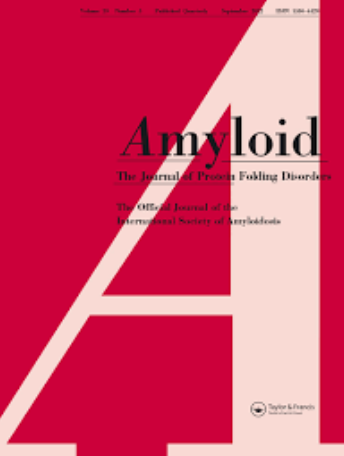棉顶绢毛猴的载脂蛋白a - iv淀粉样变性。
IF 5.2
2区 医学
Q1 BIOCHEMISTRY & MOLECULAR BIOLOGY
Amyloid-Journal of Protein Folding Disorders
Pub Date : 2023-09-01
DOI:10.1080/13506129.2023.2169603
引用次数: 1
摘要
本文章由计算机程序翻译,如有差异,请以英文原文为准。
Apolipoprotein A-IV amyloidosis in a cotton-top tamarin (Saguinus oedipus).
Apolipoprotein A-IV (ApoAIV) amyloidosis is a rare type of systemic amyloidosis characterised by ApoAIV-derived amyloid deposits in the kidney and heart [1,2]. To date, ApoAIV amyloidosis has been reported only in humans and not in animals. In this study, we performed a mass spectrometry-based proteomic analysis on a case of systemic amyloidosis in cotton-top tamarin (Saguinus oedipus) and identified ApoAIV amyloidosis with unique pathological characteristics that differ from humans. A 17-year-old female cotton-top tamarin who died in the Japanese zoo was used for the research. She had a medical history of pulmonary edema, hypothermia, diarrhoea, and loss of energy. Histologically, amyloid deposits in kidneys were severe in the cortical interstitium and glomeruli, but mild in the medulla (Figure 1(a–c)). Severe amyloid deposition was also observed in lamina propria of the intestine (Figure 1(d-f)) and in the space of Disse in the liver (Supplementary Figure 1(m–o)). In the spleen (Figure 1(g-i)),
求助全文
通过发布文献求助,成功后即可免费获取论文全文。
去求助
来源期刊

Amyloid-Journal of Protein Folding Disorders
生物-生化与分子生物学
CiteScore
10.60
自引率
10.90%
发文量
48
审稿时长
6-12 weeks
期刊介绍:
Amyloid: the Journal of Protein Folding Disorders is dedicated to the study of all aspects of the protein groups and associated disorders that are classified as the amyloidoses as well as other disorders associated with abnormal protein folding. The journals major focus points are:
etiology,
pathogenesis,
histopathology,
chemical structure,
nature of fibrillogenesis;
whilst also publishing papers on the basic and chemical genetic aspects of many of these disorders.
Amyloid is recognised as one of the leading publications on amyloid protein classifications and the associated disorders, as well as clinical studies on all aspects of amyloid related neurodegenerative diseases and major clinical studies on inherited amyloidosis, especially those related to transthyretin. The Journal also publishes book reviews, meeting reports, editorials, thesis abstracts, review articles and symposia in the various areas listed above.
 求助内容:
求助内容: 应助结果提醒方式:
应助结果提醒方式:


